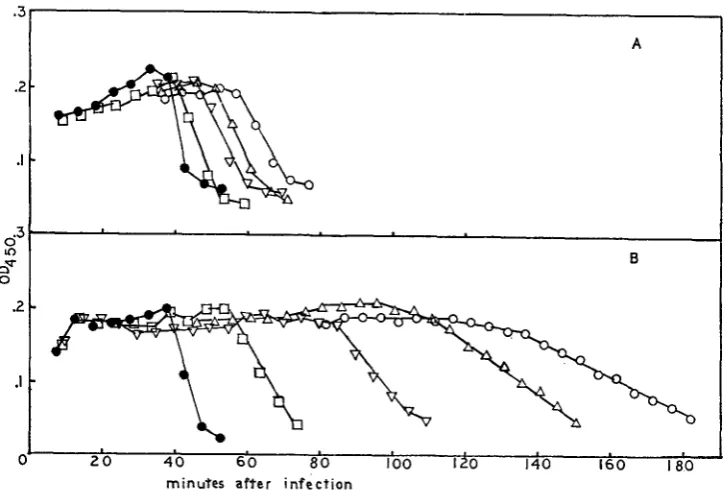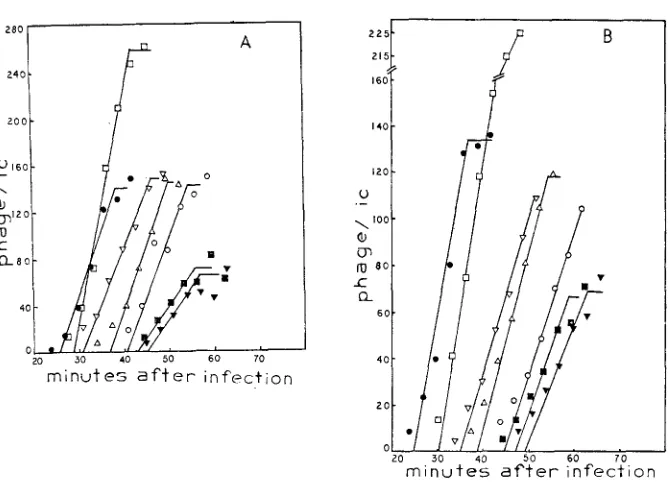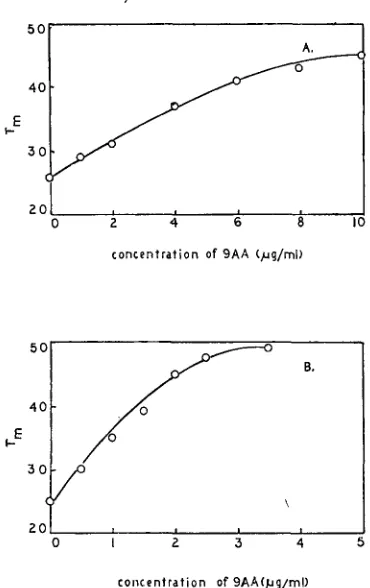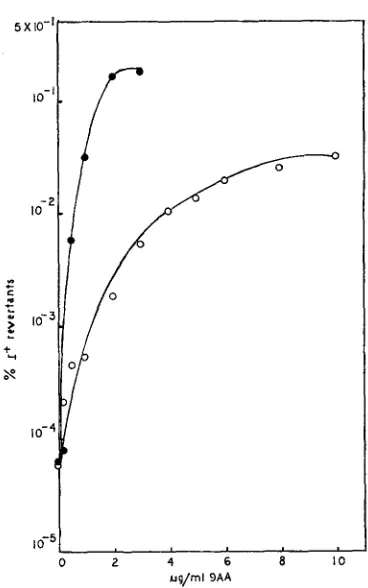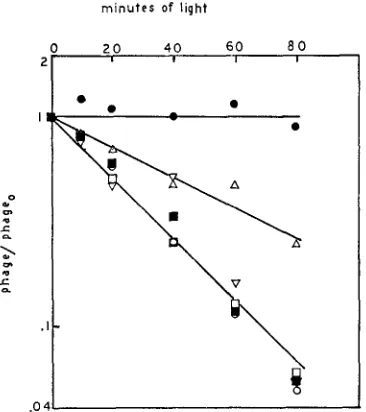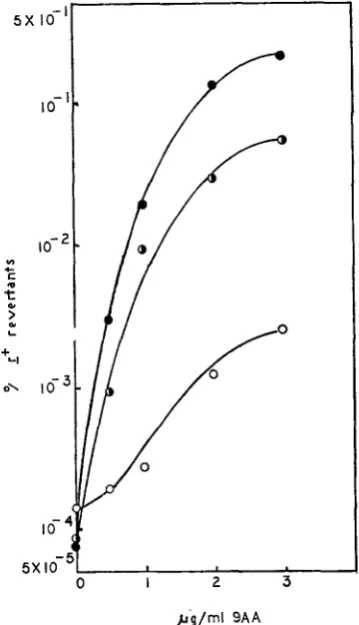SOME ACRIDINE-RESISTANT MUTATIONS OF BACTERIOPHAGE
T4D1
HARRIET RAPPAPORT, MARJORIE RUSSEL2 AND MILLARD SUSMAN Laboratory of Genetics, Uniuersity of Wisconsin, Madison, Wisconsin 53706
Manuscript received March 7, 1974
ABSTRACT
Three new 9-aminoacridine (9AA) resistant mutations of bacteriophage T4D have been isolated and characterized. Two of the mutations, rs and rc, have identical patterns od acridine resistance, but they map on opposite sides of the r l l region. In addition, rs has an effect on the plaque morphology ob r mutations, whereas rc does not. The third mutation, a m , maps very close to rs but exhibits a different pattern of resistance to 9AA. None of the three is resistant to acridines by virtue of reduced permeability. Taken together with other mutations that have been previously characterized, these new mutations permit us to set the minimum number of acridine-sensitive processes in T4 development at four.
INE-AMINOACRIDINE (9AA) has been shown to have several effects on
NT4
development in Escherichia coli ( E . coli) B/5. Both (1) the time of lysis, as measured by changes in optical density following infection, and (2) the rate of lysis, as defined by the slope of the linear portion of the lysis curve, are affected by the presence of 9AA. The time of lysis is delayed, and the rate is decreased( COUSE 1966 and 1968). (3) Recombination is stimulated in the presence of 9AA, and it has been shown that this is a direct effect of the acridine and not merely a result of the prolongation of the latent period caused by the acridine (MATTSON
1968 and 1970).
(4)
The overall mutation frequency is increased. In addition certain mutations, such as rZZUV58 (DRAKE 1963), are especially sensitive to reversion by 9AA(MATTSON
1968). (5) There is also an acridine-sensitive period between 7 and 23 minutes after infection at 30°, known as the "acridine-sensitive clock" (SUSMAN,PIECHOWSKI
and RITCHIE 1965). Pulses of 9AA of given dura- tion at any time during the sensitive period cause equivalent delays in the onset of maturation. That is, a pulse from 7-12 min. or 18-23 min. gives the same delay in time of maturation, the actual delay being a function of the concentration of 9AA used for the pulse. (6) 9AA interferes with the gene 17-controlled head finishing step (PIECHOWSKI and SUSMAN 1967). (7) There is also a change in the sedimentation pattern of DNA made in infected cells in the presence of the dye (ALTMAN and LERMAN 1970a,b; RAPPAPORT 1971). Finally, (8) if phages are grown in the presence of a photodynamic acridine such as proflavine, the phages are photoinactivable (HESSLER 1965).This is publication number 1652 from the Laboratory of Genetics, University of Wisconsm, Madison, Wisconsin 53706. Present address: Department of MCDB, Umversity of Colorado, Boulder, Colorado 80302.
580 H. RAPPAPORT, M . RUSSEL A N D M. S U S M A N
Physiological studies on the mechanism of T4 production and assembly in the 1 ) The reduction in the overall amount of DNA synthesized in the presence of
acridines is not sufficient to account for the reduction in burst size. The reduction in
DNA
is not very severe (MANSON 1954;DEMARS
1955). The sedimentation pattern of newDNA
as seen on sucrose gradients is altered(ALTMAN and
LERMAN
1970b;RAPPAPORT
1971).2)
DNA
synthesized in the presence of acridine is packaged into mature phage upon removal of the acridine (PIECHOWSKI and SUSMAN 1966).3) Serum-blocking proteins accumulate in acridine-inhibited lysates of in- fected cells, but maturation is blocked (FOSTER 1948;
DEMARS
1955). 4) Protein synthesis continues in the presence of acridine(PIECHOWSKI
andSUSMAN
1966).Several acridine-resistant mutants have been isolated. The isolation of two of these, ac, an acriflavine-resistant mutant
(EDGAR
and EPSTEIN 1961) and q, a second-step mutation from ac (SUSMAN andEDGAR,
cited in PRATT,STENT
andHARRIMAN
1961) has been previously described. ama (MCLAREN, unpublisheddata), rc
(RUSSEL
1968) and rs were selected in this laboratory as second-step mutations from q.We have studied rs, IC and ama in order to elucidate the relationships among
these mutations in the hope of defining the number of acridine-sensitive targets in infected cells and their interrelationships.
presence of acridines have shown that
MATERXALS A N D M E T HO D S
Bacteria: Host bacteria were E . coli B/5 (&STEIN et al. 1963). Indicator bacteria were E . coli B/5, S/6/5 (ibid.), CR63 (APPLEYARD, MCGREG~R and BAIRD 1956), CR63 (A) and F (1)
(STEINBERG and EDGAR 1962). A-lysogenic indicators are selective for rZZ+ phage. CR63 and CR63 ( A ) are S U + bacteria. All others ~ ~ ~ ~ ~ used are sramber.
Host bacteria were prepared by diluting an overnight culture 1000-fold into 150 ml of fresh medium, incubating with aeration at 30" for 2.5-3 hours, pelleting in the cold and resuspending in 0.5-1 ml of fresh medium. Indicator bacteria were prepared from a 100-fold dilution of an overnight culture into 150 ml of fresh medium incubated and centrifuged as described for host cultures, and resuspended in 15-20 ml of fresh medium. All bacteria were stored 0n ice or in the refrigerator until use. The normal growth medium was Hershey broth for both host and indi- cator bacteria.
Phage: The phage used in these experiments were wild-type T4D (DOERMANN and HILL 1953) ; T4DrZ48 (DOERMANN 1952) from EDGAR; T4DrZZ47; T4DrZZ73; T4BrZZPB242, trans- ferred into T4D in this lab and T4BrZZW58 (DRAKE 1963), also transferred into T4D in this
lab. Also used were the acridine-resistant phages T4DqED41 (PIFcwowsKr and SUSMAN 1967); T4Dnc4.1 (EDGAR and EPSTFJN 1961) ; T 4 D n m (MCLAREN, unpublished results) ; T4Drc (RUSSEL
1968) and T4Drs. a m , rc and TS were isolated in this laboratory as second-step mutations from
q. Many of these phages were used in various combinations of double and triple mutations. M e d i a Hershey (H) broth (STEINBERG and EDGAR 1962) was the normal gmwth medium for bacteria and phage stocks, and was used as the growth medium in most experiments. Tryptone broth was used as dilution medium f o r titering phage and bacterial suspension.
ACRIDINE-RESISTANT M U T A N T S O F T 4 581
components were autoclaved separately and mixed just before use. 10 x M9 salts are composed of 30 g Na,HP04, 15 g KH,PO,, 2.5 g NaCl and 5.0 g NH4C1 dissolved in 500 ml d i d l e d H,O. X buffer was used as dilution and suspension medium in phMoinactivation experiments. It consists of 1.36 g KH,PO, and 0.2 g (NH,),SO, dissolved in 1.0 liter H,O adjusted to p H 7.0 and autoclaved. Just before use it was supplemented to give a final concentration of le3 M Mg++, 10-4 M Ca+
+
and 10 ,ug/ml gelatin.EHA top agar and EHA battom agar (ibid.) were used, respectively, as the top and bolttom layers for assays in petri dishes.
Chemicals: 9-aminmcridine (9AA) was purchased from Mann Research Labs, dissolved in sterile distilled H,O at a concentration of 1 .O mg/ml, and stored in a brown W l e in the refriger- ator. Fresh solutions were made monthly. Proflavine and acriflavine, also fmm Mann Research Labs, were dissolved as above, and stored in foil-wrapped test tubes in the refrigerator for not
more than one week. DNase was purchased from Calbiochem, as was 5-bromodeoxyuridine (BrdU) .
Preparation of phage stocks: Phage stocks were prepared by adding 0.1 ml of a four-hour plaque resuspended in 1.0 ml of H-broth to 10 ml d H-broth plus 1.0 ml of a B/5 overnight culture and incubating overnight with aeration at room temperature. 1.0 ml of CHC1, was added, aeration was continued, and DNase was added to the lysate. The solution was centrifuged for 20 min. at 9000 rpm in a tabletop Serval1 centrifuge to remome bacterial debris.
Standard experimental procedures: Most procedures are specific in RESULTS and DISCUSSION
and are standard phage procedures according to ADAMS (1959) and STEINBERG and EDGAR (1962).
Experiments involving acriflavine, profilavine, or BrdU were performed either in dim yellow light or with foil-wrapped test tubes. All experiments and incubations were done a t 30" unless
otherwise specified.
Spot tests: Melted EHA-bottom agar was supplemented with acridine and poured into 1001 mm petri dishes. Each dish contained about 30 ml of medium. This layer was allowed to dry a t least overnight. Subsequently an overlay of 3 drops of B/5 indicator bacteria in 2.5 ml of EHA-top agar was added and individual plaques were sportted on these plates. The concentrations of dye used to test for various mutants are listed in Table 1.
Photoinuctiuation experiments: The method is adapted from HE~SLER (1965). Bacteria were grown as usual, adjusted to 109 cells/ml, and infected with phage at a multiplicity of -5. The cells were then diluted 100-fold into H-bro8th containing 0.05 pg/ml proflavine. Sixty minutes later the cells were lysed with CHC1, and the growth tubes diluted 100-fold into cold 1 buffer in glass petri dishes. Under these conditions phage are photosensitized by dye incorporated during gmwth and not by the small amount of external proflavine in the suspending medium. The lysates were then irradiated with visible light from an unshielded Sylvania Lifeline F40CW
TABLE 1
Acridine concentrations for spot tests
Mutant
Concentration of dye in bottom layer
( P d m l )
proflavine acriflavine acriflavine
9AA
9AA
QAA
.8 .2 1.5 12.0 16.0 16.0
All of these dye concentrations are restrictive for T4 wild type. Where double mutants are being tested, the dye concentration is restrictive for each of the single mutations. q is included in the latter three cases to allow the maturable phage materials to be assembled in the presence of
582 H. RAPPAPORT, M . RUSSEL A N D M. S U S M A N
fluorescent lamp at a distance of 4 cm. Samples were kept on ice during irradiation. Aliquots removed at 0, IO, 20,40,601 and 80 minutes and assayed for swlriving phage.
RESULTS
We have selected three new 9AA-resistant mutations of T4D. All were isolated by selecting from a stock of qED4l a second-step mutation more 9AA-resistant than the original q mutation. These mutants have been named rs (r-suppressor)
,
rc (rapid clock) and ama (amino-acridine).
These mutations were mapped by standard crosses. The result is shown below.rc amars ac 4
I-IS double mutants exhibit normal r-plaque morphology when plated on B/5,
but not S/6/5. The plaques on S/6/5 are the same size as wild-type, but have sharper edges. The r-suppression phenotype of IS extends to both rZ and
rZZ
point and deletion mutations. The rs plaque phenotype was examined by plating on several bacterial hosts. The results are shown in Table 2. It may also be seen from Table 2 that IS only affects the plaque morphology of r mutations:rZZ
mutations,which are normally unable to grow on h-lysogens, are not enabled to do so by the presence of rs. An experiment measuring the
O.D.
of S/6/5 infected with r48rsshowed that the altered plaque morphology was not a result of the restoration of lysis inhibition (unpublished results). (Lysis inhibition does not occur in infec- tions with r mutations.)
In order to determine if the suppressed-r plaque morphology observed on S/6/5 was a result of the T6 resistance of S/6/5, we plated r73rs on 1 3 independently isolated B/5/6 strains. In none of them was the suppressed-r plaque morphology observed. Thus it is not merely T6 resistance that determines the plaque mor- phology difference between B/5 and S/6/5. In crosses done with IS, no recom-
binants separating the plaque phenotype from the acridine-resistance phenotype were observed (unpublished data).
In an additional effort to demonstrate that rs consists of a single, pleiotropic
I
-7I
rZZAI
rZZBI
-7I I T 1
//
gene 17TABLE 2
Plaque morphology of w
Bacterium
B/5 S/6/5 CR63 CR63(X) F(X)
wild type
+
+
+
+
+
rs
+
+
+
+
+
r48 (rl) r r r r r
r48-rs r rs rs rs rs
r r
r
-
--
-rPB242 (rll)
+
rPB242-rs rs
+
ACRIDINE-RESISTANT MUTANTS O F T4 583 mutation, rather than two very closely linked mutations, attempts were made to revert either acridine resistance or r suppression. rPB242-rs-q, a triply-mutant phage carrying an rll deletion in addition to the r suppressor and q was muta- genized with acridines or with BrdU. Ten thousand plaques of this triple mutant on S/6/5 were examined for reversion of r suppression and 200 were spot-tested for reversion of rs-acridine resistance. No revertants for either phenotype were detected. One r plaque arose from BrdU mutagenesis which was still acridine- resistant. However, in crosses to q and rs both normal r and suppressed-r acridine- resistant phages segregated. Thus this was not a true revertant, but a new muta- tion which removed the r-suppression characteristic of rs. No further studies were made of this mutation except to note that it was linked to neither the rl nor r l l
regions. Thus the r-suppression phenotype of rs is subject to alteration by the genetic background of both the host bacterium and the phage. The basis of this plaque phenotype is still unknown.
Measurements of acridine resistance: As previously mentioned, 9AA has sev- eral effects on phage development. We have examined each of these processes in each of the mutants isolated.
In
most cases the process was examined both for the single mutant and q double mutant. This approach should have allowed detection of interactions of rs, rc or ama with g. In most cases data are presented only for rs. The results for ama, rc, rs-g, ama-q and rc-g will be described.Burst size: We have measured burst sizes in the continuous presence of low concentrations of 9AA. This experiment is an overall measurement of both the ability of a phage to make precursor substances such as
DNA
in 9AA as well as the ability to assemble these precursors into viable phage in the presence of 9AA (PIECHOWSKI and SUSMAN 1966). Thus the ability to overcome 9AA inhibition of early processes and the late gene-I 7-controlled head finishing step (PIECHOW-SKI and SUSMAN 1967) can be examined. Some results are shown in Table 3.
ama and IC give results similar to rs; ama-q and rc-q give results similar to rs-q
(unpublished results).
Lysis: We have also examined lysis of infected bacteria in the continuous pres-
TABLE 3
Burst size in 9AA
Concentration of 9AA (pg/ml)
0 .25 .5 1 1.5 0 (not normalized)
wild type 100 114 4.9 2.0
.w
2054 100 83 81 12 1.7 138
rs 1 00 82 72 8.8 .38 144
rsq 100 120 113 77 82 1 0
These burst sizes have been nolmdized to a value of 100 in the absence of 9AA. The actual burst sizes out of 9AA are listed in the last column. B/5 host bacteria at a final concentration of 2
x
108 cells/ml were infected with the indicated phage (m.0.i. IO), adsolrption with aeration was continued for 4.5 minutes, antiserum (k = 2 min-1) was added to remove unadsorbed phage and allowed to act for 3.5 minutes. The cells were then diluted 104-fold into growth tubes con-584 H. RAPPAPORT, M. RUSSEL AND M. SUSMAN
ence of 9AA. COUSE (1966,1968) has shown that 9AA causes a delay in the time of lysis and a reduction in the rate of lysis in T4-infected E. coli. The mechanism o f 9AA interference with lysis is not understood. Data for rs and wild-type are shown in Figure 1. One can see that rs is resistant to this effect. ama is slightly more resistant than rs; rc is nearly identical to rs; q has no effect on the results (unpublished results).
Clock: SUSMAN, PIECHOWSKI and RITCHIE (1965) have described an ''acridine- sensitive clock" which controls the time of maturation of T4. 9AA delays the time of maturation of T4 if a pulse of 9AA is given at any time from 7 to 23 minutes after infection at 30". Pulses of equal duration at any time during this period give equal delays in the time of maturation. The actual delay is concentra- tion-dependent. Data for rs and wild type are shown in Figure 2. The time of maturation (T,) is defined by the intercept with the abscissa of the back extra- polate of the linear portion of the premature lysis curve. The Tm's from Figure 2 are plotted as a function of acridine concentration in Figure 3. q is not resistant to this effect of 9AA; ama is less resistant than rs; rc is as resistant as rs (unpub- lished results).
Mutation: Acridines are efficient mutagens. rUV58 is especially sensitive to
.2
.I
A
-
-
0 3 ' 10
C i i 0
B
.2
.I
0
' 2 0 40 6 0 80 100 I20 140 160 180
minutes after infection
FIGURE 1 .-Lysis in QAA. H s t bacteria were B/5. Adsorption was with aeration for 2 min. The infected cells were then diluted 50-fold into growth tubes containing the desired concentra- tion of acridim and T4 antiserum ( K = 12 min-1). The antiserum prevents lysis inhibition by superinfecting phage. 0.D.450 was read until the cells lysed. A shows the results for rs (m.0.i. 9.8,
final bacterial concentration 1.3 X IO9 cells/ml); B the results f o r wild type (m.0.i. 10.7, final
bacterial concentration 9.7 X 10s cells/ml). ( 0 ) =no 9AA; (U) = 1 pg/ml; (inverted triangle) = 2 pg/ml; ( A ) = 3 pg/ml; ( 0 ) = 4 gg/ml.
-
ACRIDINE-RESISTANT MUTANTS O F T4 585
7
I
FIGURE %-The 9AAsensitive clock. B/5 host bacteria at the desired concentration were infected with the desired phage. Adsorption WBS continued for 1 min and antiserum ( K = 3 min-I
was added and allowed to act for 6 min. The infected cells were then diluted 100-fold into H-broth containing the desired concentration of acridine. 16 min later the cells were diluted an additional 100-fold into acridine-free medium. 1.0 ml samples were blown into CHC1, at the times indicated on the abscissa. The number of phage/infected cell was calculated and is plotted on the ordinate. A shows the results for rs (final bacterial concentration 1.1
x
IO9 cells/ml, m.o.i. 3.2). ( 0 ) =no 9AA; (0) = 1 pg/ml; ( V ) = 2 pg/ml; ( A ) = 4 pg/ml;
(0)
= 6 pg/ml; H) = 8 pg/ml;(v)
= 10 pg/ml). B shows the results for wild type (fiial bacterial concentration 8.8 X 108 cells/ml, m.0.i. 4.2). ( 0 ) = n o 9AA; (0) = .5 pg/ml; ( V ) = 1 pg/ml; ( A ) = 1.5 pg/ml;(0)
= 2 pg/ml; (U) = 2.5 pg/ml;(v)
=3.5 fig/ml.reversion by 9AA (DRAKE 1963; MATTSON 1968). By using increasing concen- trations of 9AA one can increase the reversion frequency of rUV58 from a back- ground of -IO-? to We have looked at the reversion of rUV58 in combi- nation with rs, rc and ama as double mutants; with q as a double mutant and with q and the other acridine-resistant mutants as triple mutants. Data for rUV58-rs are shown in Figure
4.
rUV58-rc, rUV58-rs-q and rUV58-rc-q give results identical to those shown for rUV58-rs; rUV58-ama, rUV58-ama-q and rUV58-q give results identical to those shown for rUV58 (unpublished results). Recombination: In addition to acting as a mutagen, 9AA stimulates recombi- nation in T4 (MATTSON 1970). We have performed crosses of r47 (rZZ A cistron) by r73 (rZZ B cistron) and scored r+ recombinants. We have done this with and without q present, as well as with ama, IS and rc. The data shown in Figure 5demonstrate the resistance of rs to this effect of 9AA. Crosses in which parents
586 H. RAPPAPORT, M. R U SS E L A N D M. S U S M A N
2 0 1
0 2 4 6 0 IO
concentration o f 9 A A (,ug/ml)
E e
201
0 I 2 3 4
colicentra ti o n of 9AA(1.lq/ml)
FIGURE 3.-Time of maturation in 9AA. These graphs are derived from the data shown in Figure 2. The values for T, were read from the abscissa in Figure 2. They are plotted here against acridine concentration. A shows data for rs, B data for wild type. Note that the scale of the abscissa in A is twice that in B .
9AA on DNA synthesis in T4. They have examined on sucrose gradients the DNA produced during infection in the presence and absence of 9AA, and have demonstrated an effect of 9AA on the pattern thus obtained. We have performed similar experiments using IC, IS, ama, q, IC-q, ama-q and wild-type T4 (RAPPA- PORT 1971 )
.
ALTMAN and LERMAN observed four components which are definedas follows for a 42 fraction sucrose gradient:
a) bottom component-first five fractions-a membrane-bound fraction with b) phage component-next 12-15 fractions-mature phage particles with
c) fast component-next 12-15 fractions-I 70-650 S DNA.
d) slow component-remaining fractions-60 S (whole phage size) DNA. Our results on sedimentation of DNA from phage-infected cells treated with 1) wild type and q show identical profiles in 9AA-both phage and fast com-
sedimentation coefficient greater than 950 S. sedimentation coefficient of about 950 S.
ACRIDINE-RESISTANT MUTANTS O F T4
5 X IO-'
10
- 2
10
n
r
C
*
..
. . .
i
Io-:
..
+-I
x
lo-'
Io-!
2 4 6 0 10 ug/ml 3 A A
587
FIGURE 4.-Reversion of r W 5 8 in QAA. B/5 host bacteria, final concentration 5.9
x
108cells/ml, were infected with the desired phage. Adsorption was continued for 1.5 min. Antisenun was added ( K = 3 min-1) and allowed ta act for 3.5 minutes. The infected cells were diluted 20-fold into grwwth tubes containing H-broth plus the desired concentration of 9AA. 25 min later the cells were diluted 100-fold into acridine-free medium. Growth was continued for 60 min when CHC1, was added. Total phage were assayed on S/6/5, r+ revertants on CR63 ( I ) . ( ) = values for r W 5 8 (m.0.i. 6.6); ( 0 ) =values for r W 5 8 rs (m.0.i. 5).
2) ama, IC and rs all show much more fast component than wild type or q, but
show little if any phage component.
3 ) rc-q and ama-q (and presumably also rs-q) show fast component profiles similar to those they show without q, but also show some phage component. Permeability: All of the effects so far discussed have been tested with 9AA, rather than acriflavine or proflavine (two other acridines). An acriflavine-resist- ant mutant (ac; EDGAR and EPSTEIN 1961 ) has been previously described which seems to be resistant by virtue olf decreased permeability to acridines. This has been demonstrated with both fluorescence measurements (SILVER 1965) of acri- flavine uptake and photoinactivation measurements (KAUFMANN and
HIATT
588 H. RAPPAPORT, M . RUSSEL A N D M. S U S M A N
pg/ml 9 A A
FIGURE 5.-Recombinabon in 9AA. B/5 host bacteria, final concentration 5.3 x 108 cells/ml, were infected with a mixture of the desired phages. Adsorption was continued for 1.5 min and antiserum ( K = 3 min-1) was added and allowed to act for 4.5 min. The infected cells were diluted IQO-fold into growth tubes containing H-broth plus the desired concentration of 9AA. 24 min later the cells were diluted an additional IWfold into acridine-free media. Growth was continued for 60 min, when CHC1, was added. Total phage were assayed on S/6/5, r+ recombi- nants on CR63 ( A ) . ( 0 ) =values for crosses of r47
x
r73 (total m.0.i. 10, ratio of r47:r73 inphage mix 1:2). ( 0 ) =values for crosses of r47 rs x 7-73 rs (total m.0.i. 11.2, ratio of 7-47 rs:r73
rs in phage mix 1 :I).
published results) and 9AA is not a photoinactivating acridine, the resistance of these phages to acriflavine and proflavine was determined. The results are shown in Table 4. Proflavine is the only dye to which all of the mutants were resistant. Therefore it was used in photoinactivation to determine if any of the mutants seemed to be resistant by virtue of decreased acridine permeability. The results are shown in Figure 6. Only ac-infected bacteria show decreased permeability to proflavine when compared to wild-type infected bacteria. We can therefore con- clude that IC, IS, ama and q affect intracellular processes in phage development.
Dominance of rs: We have examined dominance of rs in mixed infections of
TABLE 4
Resistance of mutants to diflerent acridines
Mutant 9AA Acriflavine Proflavine
UC
4 a m a
rc rs
0
+
+
+
+
+
+
0 0 0+
+
+
+
+
+
indicates resistance, as compared to wild type, 0 indicates sensitivity equal to wild type.AC R ID I NE - RE S IS T AN T M U T A N T S O F T 4 589
minutes of light
FIGURE 6.-Photoinactivation with prosflavine. The experimental procedure is described in
MATERIALS AND METHODS. The data are from several experiments, all of which include rUV58
as the wild type control. Slopes of cui-ves in different experiments were adjusted so that the
slope of UV58 in the presence of acridine was constant. B/5 host bacteria at an average find concentration of 4.8 x 108 cells/ml were used. Pro'flavine was used at a concentration 0.05 p g / d ( 0 ) = values for rUV58, no proflavine. All &er phages used give identical results in the absence of dye (unpublished results). (U) = rUV58 in dye (m.0.i. 3.3); ( V ) = rUV58 rs in dye (m.0.i. 2.5); ( A ) =rUV58 at in dye (m.0.i. 5.3); ( 0 ) =rUV58 rc in dye (m.0.i. 6.9);
(m)
= rUV58 a m in dye (m.0.i. 11 2 ) . rUV58 is present for reasons not relevant to this e x p i - ment; the response of UV58 cannot be distinguished from t hat of wild type (unpublished results).mutant and wild-type for sensitivity to 9AA-induced reversion (Figure 7), recombination, or reduction in burst size. In all cases we found intermediate acri- dine sensitivity (Figure 7 and unpublished results). Thus IS and wild type are
codominant.
DISCUSSION
A general summary of the data is presented in Table
5.
One can see that, as previously reported (SILVER 1965; HESSLER 1965), ac (or pr in T2) reduces cell permeability to proflavine. ac is not 9AA-resistant; so it presumably does not reduce permeability to 9AA. q also has been previously described(PIECHOWSKI
and SUSMAN 1967). q maps in gene 17 and seems to render only the late head- finishing process controlled by gene 17 resistant to 9AA. We see no effect of590 H. RAPPAPORT, M. RU S SE L A N D M. S U S M A N
5 X l o 3 L 1
0 I 2 3
bg/ml 9 A A
FIGURE 7.-Dominance: reversion in a mixed infection. The experimental procedure was that described for Figure 4. B/5 host bacteria were used at a final concentration of 6.3 x 108 cells/ml. Indicator bacteria were as for Figure 4. (
e
) = values for rUV58 (m.0.i. 8.2) j ( 0 ) = rUV58rs (m.0.i. 5.5); (half-dosed circles) = mixed infection with both of these phages (total m.0.i. 6.9,ratioof rUV58:rUV58 rsintheinputphage 1.5:l).
TABLE 5
Patterns of resistance of five acridine-resistant mutants
Phage Stimulation of Photom-
assembly Clock Lysis Mutation Recombination activation DNA
- - -
-
-
wild type
-
- --
-
-+
+
+
-
9
+++
rs
+
++
+
+
+
+
rc
+
++
+
+
a m
+
+
++
--
-
-
ac nt nt nt nt nt
+
nt+
= resistant-
= sensitive nt = not testableACRIDINE-RESISTANT M U T A N T S O F T 4 591
RITCHIE
1965)-while gene 17 controls a later step in phage development (PIE-CHOWSKI and
SUSMAN
1967). Presumably the other mutants affect burst sizeby increasing the amount of precursors produced in the presence of acridine. These precursors are then assembled into phage with low, wild-type efficiency rather than q efficiency.
ama, IC and IS divide the early acridine-sensitive processes into at least two
groups. Since a m a is not resistant to the effect of 9AA on mutation and recombi- nation, these effects are in some way distinct from the effects on lysis, time of maturation, and DNA synthesis to which a n a is resistant. A distinction between these processes is indicated by other sorts of evidence as well. One can use the data presented in RESULTS to calculate the factor by which rs increases acridine
resistance. This has been done for lysis, time of maturatioln, reversion and recom- bination. Acridine dosage for rs must be multiplied by a factor of about
4
or 5 to produce delays in maturation or lysis equal to wild type. For recombination and reversion, however, this factor is about 8-10. IC gives the same results (Rus-SEL 1968).
Using the data presented one can estimate the minimum number of acridine- sensitive “targets” in T4 development. (1) There is one group of 9AA-sensitive processes (clock, lysis, fast component DNA) protected by rc, rs and ama. (2) There is a second group (mutation and recombination) protected by rc and rs.
( 3 ) There is a late assembly step protected by q.
(4)
There is a permeability barrier to some acridines that is influenced by ac. There are also indications that further distinctions can be made between these processes. rc, rs and a m a are all resistant to inhibition of the clock and of lysis, but rs and IC are more resistantthan a m a to the “clock” effect while a m a is more resistant to the lysis effects (unpublished results). Furthermore,
MATTSON
(1968) has shown that con- current protein synthesis is necessary for 9AA stimulation of recombination, butis not necessary for 9AA stimulation of mutation. Thus it seems likely that the actual number of 9AA targets is greater than four.
This work was suppo~rted in part by Public Health Services Research Grant No. ROI-AlC6855
from the National Institute of Allergy and Infectious Disease. M.R. was supported by Public Health Service Training Grant No. GM-398 from the National Institute of General Medical Sciences.
LITERATURE CITED
~ A M S , M. H., 1959
ALTMAN, S. and L. S. LERMAN, 197Oa
Bacteriophages. Interscience. New York.
Kinetics and intermediates in the intracellular synthesis of bacteriophage T4 deoxyribonucleic acid. J. Mol. Biol. 50: 235-261. -, 1970b Effects of 9-amino-acridine on bacteriophage T4 deoxyribonucleic acid synthesis. J. Mol. Biol. 50: 263-277.
Mutation to extended host range and the occurrence of phenotypic mixing in the temperate coliphage lambda. Virology 2 : 565- 574.
Inhibition d lysis of T4infected Escherichia coli B/5 by 9-aminoacridine and its relation to the control of phageLinduced lysis. Ph.D. thesis, University of Wisconsin.
-
,APPLEYARD, R. K., J. F. MCGREGOR and K. M. BAIRD, 1956
COUSE, N. L., 1966
592 H. R A PP A PO R T , M. RUSSEL A N D M. S U S M A N
DEMARS, R. I., 1955 The production of phage-related materials when bacteriophage develop ment is interrupted by proflavine. Virology 1 : 83-99.
DOERMANN, A. H., 1952 The intracellular growth of bacteriophages. I. Liberation of intra- cellular bacteriophage T4 by premature lysis with another phage or cyanide. J. Gen. Physiol. 35: 645-656.
DOERMANN, A. R. and M. B. HILL, 1953 Genetic structure of bacteriophage T4 as described by
DRAKE, J. W., 1963 Properties of ultraviolet induced rII mutants of bacteriophage T4. J. Mol.
EDGAR, R. S. and R. H. EPSTEIN, 1961 Inactivation by ultraviolet light of an acriflavine-sensitive gene function in phage T4D. Science 134: 327-32.8.
EPSTEIN, R. H., A. BOLLE, C. M. STEINBERG, E. KELLENBERGER, E. BOY DE U TOUR, R. CHEVALLY,
R. S. EDGAR, M. SUSMAN, G. H. DENHARDT and A. LIELAUSIS, 1963 Physiological studies of conditional lethal mutacts of bacteriophage T4D. Cold Spring Harbor Symp. Quant. Biol.
28: 375-392.
FOSTER, R. A. C., 1948 An analysis of the action of proflavine on bacteriophage g o d . J. Bacteriol. 56 : 795-809.
HESSLER, A., 1965 Acridine resistance in bacteriophage T2H as a function of dye penetration measured by mutagenesis and photoinactivation. Genetics 52 : 71 1-722.
KAUFMAN, E. and C. W. HIATT, 1959 Photodynamic action of proflavine on "2 coliphage. Virology 9 : 478-479.
MANSON, L. A., 1954 Effect of proflavine on bacteriophage synthesis. Federation Proc. 13: 503. MATTSON, T. L., 1968 Genetic effects of 9-aminaacridine on bacteriophage T4. PbD. thesis, University of Wisconsin.
-
, 1970 Recombination of bacteriophage T4 stimulated by 9-aminoacridine. Genetics 65 : 535-544.PIECHOWSKI, M. M. and M. SUSMAN, 1966 Studies on phage development. 111. The fate of T4 DNA and protein synthesized in the presence of 9-aminoacridine. Virology 28: 396-403.
-
, 1967 Acridine-resistance in phage T4D. Genetics 56: 133-148.P m m , D., G. S. STENT and P. D. HARRIMAN, 1961 Stabilization to 32P decay and ollset of DNA replication of T4 bacteriophage. J. Mol. Biol. 3: #W%.
RAPPAPORT, H., 1971 Acridine-resistance in phage T4: Some acridine-resistant mutations. P b D . thesis, University of Wisconsin.
RUSSEL, M. E., 1968 An acridine-resistant mutation in phage T4. M.S. thesis, University of Wisconsin.
SILVER, S., 1965 Acriflavine resistance: a bacteriophage mutation affecting the uptake of dye by the infected bacterial cells. Proc. Natl. Acad. Sci. U.S. 53: 24-30.
STEINBERG, C. M. and R. S. EDGAR, 1962 A critical test of a current theory of genetic recombi- nation in bacteriophage. Genetics 47: 187-208.
SUSMAN, M., M. M. PIECHOWSKI and D. A. R I T C H I ~ 1965 Studies on phage development. I.
An acridine-sensitive clock. Virology 26: 163-1 74.
Corresponding editor: B. D. HALL recombination studies of factors influencing plaque morphology. Genetics 38 : 79-90.

